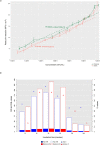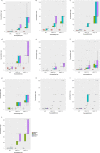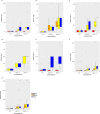Simple fluorometric-based assay of antibiotic effectiveness for Acinetobacter baumannii biofilms
- PMID: 31004100
- PMCID: PMC6474882
- DOI: 10.1038/s41598-019-42353-0
Simple fluorometric-based assay of antibiotic effectiveness for Acinetobacter baumannii biofilms
Abstract
Despite strengthened antimicrobial therapy, biofilm infections of Acinetobacter baumannii are associated with poor prognosis and limited therapeutic options. Assessing antibiotics on planktonic bacteria can result in failure against biofilm infections. Currently, antibiotics to treat biofilm infections are administered empirically, usually without considering the susceptibility of the biofilm objectively before beginning treatment. For effective therapy to resolve biofilm infections it is essential to assess the efficacy of commonly used antibiotics against biofilms. Here, we offer a robust and simple assay to assess the efficacy of antibiotics against biofilms. In the present work, we carefully optimized the incubation time, detection range, and fluorescence reading mode for resazurin-based viability staining of biofilms in 96-well-plates and determined minimal biofilm eradication concentrations (MBECs) for A. baumannii isolates from patients with chronic infection. By applying this assay, we demonstrated that antibiotic response patterns varied uniquely within the biofilm formation of various clinical samples. MBEC-50 and 75 have significant discriminatory power over minimum inhibitory concentrations for planktonic suspensions to differentiate the overall efficiency of an antibiotic to eradicate a biofilm. The present assay is an ideal platform on which to assess the efficacy of antibiotics against biofilms in vitro to pave the way for more effective therapy.
Conflict of interest statement
The authors declare no competing interests.
Figures






Similar articles
-
A rapid and simple method for routine determination of antibiotic sensitivity to biofilm populations of Pseudomonas aeruginosa.Ann Clin Microbiol Antimicrob. 2020 Mar 13;19(1):8. doi: 10.1186/s12941-020-00350-6. Ann Clin Microbiol Antimicrob. 2020. PMID: 32169075 Free PMC article.
-
Halicin Is Effective Against Staphylococcus aureus Biofilms In Vitro.Clin Orthop Relat Res. 2022 Aug 1;480(8):1476-1487. doi: 10.1097/CORR.0000000000002251. Epub 2022 May 17. Clin Orthop Relat Res. 2022. PMID: 35583504 Free PMC article.
-
Osmotic Compounds Enhance Antibiotic Efficacy against Acinetobacter baumannii Biofilm Communities.Appl Environ Microbiol. 2017 Sep 15;83(19):e01297-17. doi: 10.1128/AEM.01297-17. Print 2017 Oct 1. Appl Environ Microbiol. 2017. PMID: 28733283 Free PMC article.
-
Prevalence of biofilm producing Acinetobacter baumannii clinical isolates: A systematic review and meta-analysis.PLoS One. 2023 Nov 30;18(11):e0287211. doi: 10.1371/journal.pone.0287211. eCollection 2023. PLoS One. 2023. PMID: 38032906 Free PMC article.
-
Comprehensive Approaches to Combatting Acinetobacter baumannii Biofilms: From Biofilm Structure to Phage-Based Therapies.Antibiotics (Basel). 2024 Nov 8;13(11):1064. doi: 10.3390/antibiotics13111064. Antibiotics (Basel). 2024. PMID: 39596757 Free PMC article. Review.
Cited by
-
Novel colistin-EDTA combination for successful eradication of colistin-resistant Klebsiella pneumoniae catheter-related biofilm infections.Sci Rep. 2021 Nov 4;11(1):21676. doi: 10.1038/s41598-021-01052-5. Sci Rep. 2021. PMID: 34737361 Free PMC article.
-
Prognostic Factors That Affect Mortality Patients with Acinetobacter baumannii Bloodstream Infection.Infect Drug Resist. 2024 Sep 3;17:3825-3837. doi: 10.2147/IDR.S475073. eCollection 2024. Infect Drug Resist. 2024. PMID: 39247754 Free PMC article.
-
An Explorative Review on Advanced Approaches to Overcome Bacterial Resistance by Curbing Bacterial Biofilm Formation.Infect Drug Resist. 2023 Jan 5;16:19-49. doi: 10.2147/IDR.S380883. eCollection 2023. Infect Drug Resist. 2023. PMID: 36636380 Free PMC article. Review.
-
Rescued chlorhexidine activity by resveratrol against carbapenem-resistant Acinetobacter baumannii via down-regulation of AdeB efflux pump.PLoS One. 2020 Dec 2;15(12):e0243082. doi: 10.1371/journal.pone.0243082. eCollection 2020. PLoS One. 2020. PMID: 33264338 Free PMC article.
-
Genetically engineered phages and engineered phage-derived enzymes to destroy biofilms of antibiotics resistance bacteria.Heliyon. 2024 Aug 3;10(15):e35666. doi: 10.1016/j.heliyon.2024.e35666. eCollection 2024 Aug 15. Heliyon. 2024. PMID: 39170521 Free PMC article. Review.
References
Publication types
MeSH terms
Substances
LinkOut - more resources
Full Text Sources
Molecular Biology Databases

